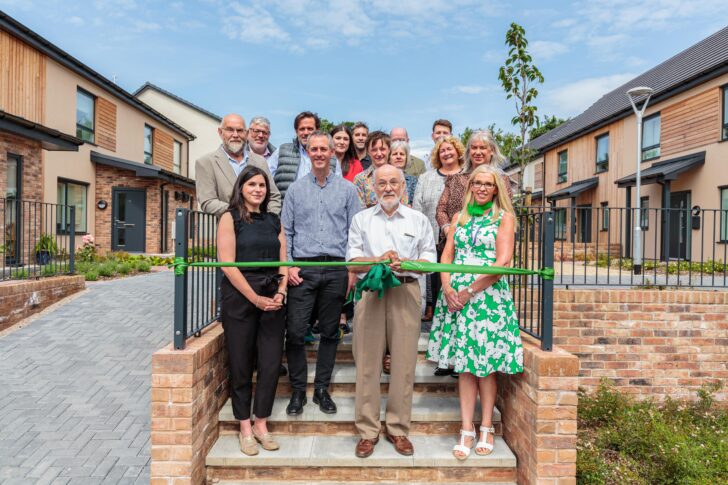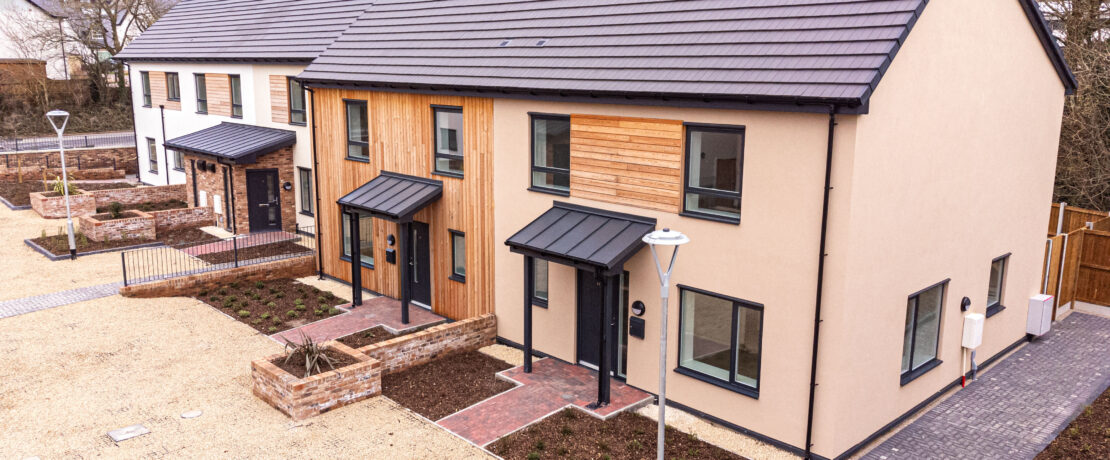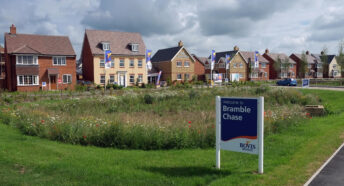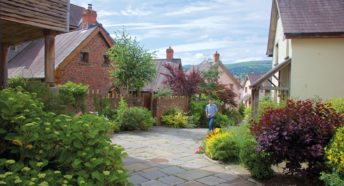A Q&A with Charles from the Lune Valley Community Land Trust
Lune Valley Community Land Trust (CLT) is a not-for-profit co-operative organisation run by members. In addition to providing affordable homes for the local community, they also aspire to manage open spaces to boost access to nature, recreation opportunities and biodiversity.
Amidst our affordable housing crisis, organisations like Lune Valley CLT are helping to provide practical and workable solutions that provide much-needed affordable homes and strengthen communities. We know that when rural communities thrive, so does our countryside. We caught up with Charles Ainger, a trustee at Lune Valley CLT, to find out more.
In your opinion, what are the benefits of social or affordable housing?
Our vision is that a safe, healthy, spacious home, that is affordable to rent/own and heat, is a human right. It is the absolute bedrock of family life, allowing families to thrive. So many other difficulties are easier to deal with if you have that as a base. If a family cannot afford such a home at market prices, access to affordable homes greatly benefits the family and wider community, because it reduces many other costly difficulties. Also, with a community-friendly site layout, well-designed affordable housing can encourage building important connections and relationships with neighbours.
What inspired the creation of Lune Valley CLT?
As local Halton residents, we saw three large new commercial housing sites being developed in our village. The developers built to the minimum legal energy standard, provided space less than national space standards, and provided only about half the policy percentage of affordable homes, by arguing abnormal costs through viability assessments.
We thought this outrageous. We communicated with the first two developers, asking them to build affordable homes to higher standards, but with no success. This inspired us to do it ourselves, and show what can and should be achieved. We set up as a CLT, taking advice from COOP as to the best legal structure – we are a Community Benefit Society, and an Exempt Charity.
How did you get the land?
A local site was available, but at a market price. Lancaster City Council (LCC), who have been hugely supportive, bought the land for us using their Section 106 (S106) funds.
How has the CLT benefited the community?
Our main benefit to Halton is in providing 20 affordable homes – 13 rented, and seven for shared ownership. These have nearly all gone to local people, through our prioritised Local Letting Agreement with LCC and our development and management partners, South Lakes Housing (SLH).
The involvement of our community-based CLT, as freehold landowner of the site, qualifies these homes as ‘community-led’. This allows us to prohibit ‘Right to Acquire’, and to require the Shared Ownership homes to be offered back to SLH on sale. So the homes remain affordable in perpetuity (in the same way that ‘Rural Exception Sites’ can). This is vital in smaller rural communities, where there is often no more local land to build replacements on if affordable homes are lost to the private market.
The homes are built to the very high Passivhaus energy/insulation standard, so they are virtually zero carbon. Of course, this means much lower heating bills, so residents can afford their heat and hot water. They are also of timber-frame construction, not concrete blockwork. This means their embodied carbon (the carbon ‘sunk’ in the materials and construction process) is lower, and meets the RIBA’s latest targets. Another vital impact of the Passivhaus energy standard, for all the Lune Walk residents, is much lower energy bills, so the homes are affordable to heat, with no fuel poverty.
Because of our leasehold arrangement for this site with SLH, who raised the finance to build the scheme, we did not raise community shares, so do not pay interest to local investors. Although we take a ground rent from SLH (which secures our basic income to run the CLT), we do not make a surplus, so cannot provide charitable donations to village causes. This may change with future schemes.

What housing mix is on the site?
The housing mix on the Lune Walk site was decided in consultation with Lancaster City Council (LCC) housing department, and checked by the results of a Housing Survey of the parish and surrounding parishes. The resulting mix is: 4x 1 bed, 2 person flats; 8x 2 bed, 4 person houses; 6x 3 bed, 5 person houses and 2x 4 bed, 7 person houses – 20 homes in all. It is really important to get this mix right to match identified local need. This is another thing that commercial developers usually do not do.
In what ways has the scheme addressed the social needs of its diverse resident population?
We cater to these needs in three main ways. Firstly we provide a mix of home sizes matching the result of our housing need survey (including elderly residents wanting to downsize but stay in their community). Secondly, we design the downstairs flats to an accessible and adaptable specification (including wet rooms). Thirdly, site layout design includes a communal space between the homes to encourage interaction and shared use of the open spaces.
Can you discuss the process of obtaining approval for the project?
We were able to meet the key challenges thanks to developing a good relationship with our local authority, Lancaster City Council (LCC). However, some of the challenges included:
- Finding a site, and being able to afford to buy it. We were lucky that one was locally available, and that our local authority was able to fund its purchase.
- Finding a Housing Association partner, and getting funded for the pre-development costs to get through planning permission. Again, LCC was key to this, allocating funds from their community-led homes grant scheme.
- Obtaining planning permission. South Lakes Housing’s (SLH) experience in gaining design and planning permission sped this up. Because of our CLT community involvement and publicity for the scheme, there was community support, and no local planning objections to the scheme – particularly because the homes are for local people. This is in contrast to the three commercial schemes, which had strong opposition.
- Agreeing the 150 year development lease between the CLT and SLH. Although there were prior examples of CLT-HA leases, mainly in southwest England, ours was more ambitious, in building in Passivhaus standard, homes and affordable homes in perpetuity. LCC funded our legal costs for this, and we were able to agree on the difficult points.
What are the barriers to delivery of affordable and social housing?
In general, there is too much dependence on commercial developers, their culture, and their ability to argue to reduce affordable home numbers on ‘viability’ terms. There’s also a lack of funding, and government policy is a barrier (although this might change with the new government). There’s a lack of recent experience and capacity in local authorities, and freezing the Local Housing Benefit rate for the last few years is a challenge. Also the recent ~25% increase in general building costs has required higher subsidy grants from Homes England.
Do you have any thoughts or experiences surrounding poor house quality?
The CLT homes are of Passivhaus standard. Good quality is essential. In our view, it is vital for all homes, providing soundproofing and high healthy air quality, as well as low energy bills and near zero carbon heating and hot water. The system completely eliminates any condensation or mould, which affects so many homes, and peoples’ health, today. Unlike homes to lower standards, they will not need retrofitting to meet the UK’s net zero by 2050 target. Experience shows that Passivhaus standard homes typically show much more reliably good construction quality, compared to typical homes, because of the rigorous materials specifications, and regular site inspections and record keeping required for Passivhaus certification.
What has been your experience of dealing with local authorities?
We have been lucky, compared to other stories we have heard. LCC has been very supportive throughout, even seeing the scheme as an example for them and others. From their Community-Led Homes fund, they provided early small scale grants, and a substantial ‘pre-development’ costs grant to take us from early design to getting planning permission. They helped us find a compatible Housing Association to partner with for delivery, and funded buying the land with S106 funds. They now aspire to adopt the same specification for their own affordable homes scheme in Lancaster, subject to grant support and financial viability.
How about housing associations?
Once we had determined our key outline ideas for the scheme – number of homes, their space, type of site layout and Passivhaus energy standard – we decided to seek a Housing Association partner to deliver the scheme; for design, planning permission, construction development and long term management. From a shortlist of three, we chose SLH. They are regionally-sized and based, and sought to ‘go green’ on a scheme. They saw our offer as an opportunity. We were able to develop a strong and respectful partnership with them, taking part in the design team, and dealing with occasionally difficult legal negotiations to develop a 150 year development lease. Partnering with a housing association has provided us with capacity, resources and expertise, as well as financial support.
How do you feel the strategies of Lune Valley could be used wider across England?
We think that these innovative aspects of our Lune Walk scheme could be applicable across the UK:
- Design to Passivhaus energy standard – for zero carbon readiness, and no fuel poverty.
- Involve a community-based CLT, so the homes qualify as Community Led – ensuring that they match actual local need, remain affordable in perpetuity, and minimise local opposition.
- Partner with a local HA for delivery – so that the energy of local activists can be spent on defining the need, setting the standards, and gaining local support, rather than doing all the admin, regulatory and management work themselves, and taking all the financial risk. We think partnering in this way makes the role for local activists less daunting, and could help to ‘scale up’ the delivery of homes via CLTs.
What support should be given to communities that wish to develop affordable housing?
Our CLT’s focus now is on working out how to help other rural communities get the affordable homes they all need. They need three things to get going:
- Some local affordable housing activists, to provide the ‘community’ angle – and help to then take those ideas forward. Finding them might come via the Parish Council or other contacts; and further help might be from an existing CLT, like Lune Valley CLT.
- Start-up funding for organising, research into housing need, and feasibility work.
- Possible land sites for new homes, conversions, or existing home purchase opportunities. These might come from church land or buildings, LA land, friendly local landowners, or building owners. One new route for such support is the Rural Homes Enabling Service (RHES).
If you could say anything to the government about the current state of rural affordable housing, what would it be?
We’d say lots of things, including:
- Update Energy Performance Certificates, and then Building Regulations, and revise them to absorb and be compatible with ‘fabric first’ Passivhaus calculations and features
- Set ‘Passivhaus Plus’ (PH with Solar PV and battery storage) as the standard for all new homes, including affordable and social housing.
- Instruct Homes England [HE] to increase their Capital Grant levels to CLTs and HAs, emphasising their ‘innovation’ driver, to enable such building to standards, in spite of the recent large increase in construction costs.
- instruct HE to provide ‘revenue’ funds too, to CLTs and other housing start-ups, for pre-development costs – either directly, or vis sub-grants to LAs, as in the CLH finding in 2017,
- Rapidly review Defra’s currently piloted Rural Homes Enabling Service (RHES), learn its lesson and roll it out country-wide.
- Galvanise the housing eco-retrofit programme, revise the retrofit boiler replacement and electricity conversion and insulation grant programme, to work within a wider, Net Zero Neighbourhood framework, including home improvements, local green spaces, and modal shift in local transport – as is being pioneered by West Midlands Development Authority.
Our rural affordable housing campaign
A healthy home is the foundation for a decent life. But our broken planning system is failing to deliver the affordable homes we need. We’re calling on the government to recognise this crisis and deliver a new generation of genuinely affordable homes in-line with local incomes. Find out more here, and join our rural affordable housing campaign here.






